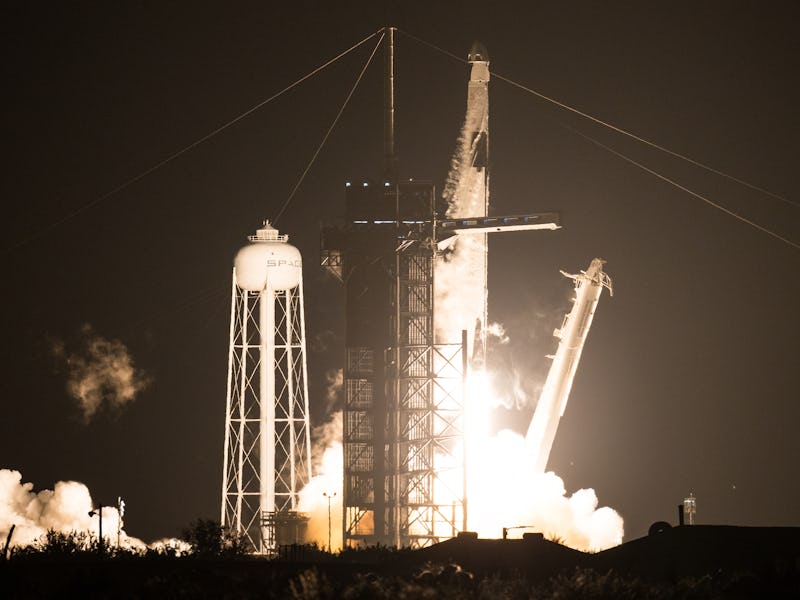SpaceX Crew Dragon: 10 stunning images and videos show the historic launch
SpaceX's human-carrying Crew Dragon looks impressive.

The Crew Dragon has done it again.
SpaceX's human-carrying capsule, designed to help NASA send astronauts to and from the International Space Station, successfully launched with four astronauts Sunday evening. The "Crew-1" mission, the first non-test crewed mission for the capsule, lifted off at 7:27 p.m. Eastern from Launch Complex 39A at the Kennedy Space Center in Florida.
Like this article and want to see more? Check out Musk Reads+ for exclusive interviews, analysis, and more.
The successful launch sent up NASA astronauts Michael Hopkins, Victor Glover, and Shannon Walker. They were joined by Soichi Noguchi from Japanese space agency JAXA. The capsule lifted off on a SpaceX Falcon 9 booster. During and after the launch, SpaceX and NASA released an impressive array of images showing the moment as it unfolded.
Crew Dragon with the arm in place.
“This is a great day for the United States of America and a great day for Japan,” NASA administrator Jim Bridenstine said in a statement. “We look forward to many more years of a great partnership — not just in low-Earth orbit but all the way to the Moon.”
It's a landmark moment for SpaceX's project, part of NASA's Commercial Crew program. Following the space shuttle's last flight in 2011, NASA had been using Russian space rockets to send its astronauts to and from the International Space Station. The new Crew Dragon brings these flights a little closer to home.
The crew walking out to the launchpad.
The mission was the first time that the Crew Dragon had successfully completed a non-test crewed mission. It followed the launch of NASA astronauts Bob Behnken and Doug Hurley in May, a mission dubbed "Demo-2."
The crew next to the specially-branded Tesla Model X.
On November 10, NASA announced it had completed the signing of the Human Rating Certification Plan. This made Crew Dragon and associated systems the first spacecraft system in history that can transport humans to and from the International Space Station.
The rocket lifting off.
The capsule packs an array of advanced technology. It has three touchscreen displays, which the company explains enable the crew to fly the capsule manually if needed. The crew also has the option to let the capsule fly autonomously, as it's designed to do so by default.
The capsule includes a set of SuperDraco thrusters. Had the launch gone wrong, these thrusters would have enabled the capsule to move itself away from the Falcon 9 and get the crew to safety.
These thrusters are powerful. During the in-flight abort test in January, the capsule achieved a velocity of Mach 2.2, more than double the speed of sound.
Vice president Mike Pence congratulates the team.
Following the launch, the Falcon 9 booster successfully landed on the Just Read the Instructions droneship. This booster will be used to fly the next team of astronauts, as part of the mission "Crew-2."
“We’re not done yet; we need to keep going,” Kathy Lueders, associate administrator for Human Exploration and Operations at NASA headquarters, said in a statement. “That spacecraft is out there with those four precious crew members on it. And we’re going to get them safely to the International Space Station tomorrow.”
The mission is scheduled to autonomously dock with the space station at around 11 p.m. Eastern on Monday, November 16.
The Inverse analysis — The successful flight is great news for NASA's upcoming plans. The agency is expected to send up the "Crew-2" mission in early 2021, followed by "Crew-3" in late 2021.
But this is part of a new era of commercial spaceflight, perhaps best demonstrated by a planned Crew Dragon mission that will send up Tom Cruise to shoot a movie in space. What else could easier access to space enable?